OHSU Health Hospital at Home
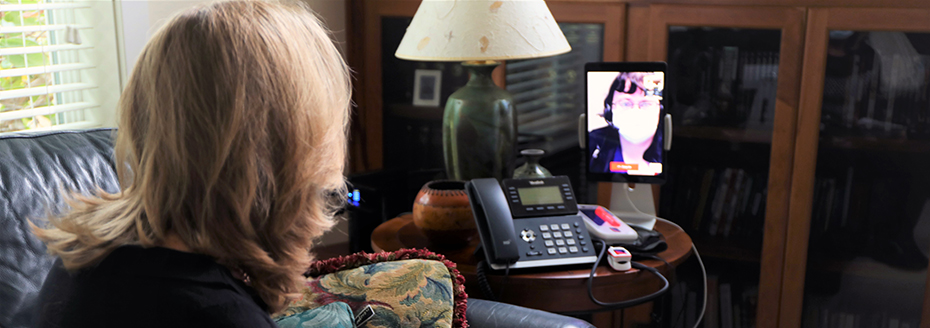
OHSU Health Hospital at Home offers the care you need in your own home. When you’re recovering from illness, the hospital may be the last place you want to be. Hospital at Home brings the hospital to you.
We offer:
- Care focused on you where you feel most safe and comfortable.
- Hospital-level care, including IV therapy, lab tests and imaging.
- Instant access to your care team, 24 hours a day, seven days a week.
- Better outcomes than staying in the hospital. Hospital at Home patients recover faster and are less likely to return to the hospital.
What is Hospital at Home?
OHSU Health Hospital at Home brings hospital care to you. Our doctors, nurses and other professionals treat you and monitor you in your own home just like they would in the hospital. We give you personalized care and frequent contact with your care team, in the comfort of your own home.
You can think of Hospital at Home as the newest unit to OHSU, an innovative care model, which essentially allows for the care services that traditionally have been limited to the physical hospital setting, but instead now we can do that within the comfort of the patient's own home.
A good Hospital at Home patient is someone with the appropriate medical diagnoses, who's clinically stable, and is able to engage with their healthcare providers in using virtual technology.
Patients are tethered to their nurse and physician care team 24/7, just like they would be in a physical hospital. When the patient is transferred from the emergency department or the main hospital to home, the technician accompanies them home and helps set up that tech in the home.
Technology includes an iPad, which allows the patient to be connected to their care team 24/7. So with one touch, all they have to do is tap the iPad, and that generates a video call to their nurse team. So anytime they need anything, if they have a question about their medication or if they want to talk to the doctor, it's same thing as hitting their call light here in the hospital.
We also provide the patient with an emergency response bracelet. It looks a lot like an Apple Watch. So let's say that they're away from the iPad and they need help. All they have to do is tap the screen of this bracelet and that calls the nurse.
Other parts of the technology install are the help button box and safety monitoring devices. We make sure that the WiFi is working. We also install a backup generator and backup WiFi services.
Patients get their vital sign monitoring devices, so blood pressure cuff, pulse oximeter, a scale, which is especially important for our heart failure patients. And then a concierge style telephone, which is a direct line to their nursing care team.
There are a lot of things that we can do for patient care in the home. We can do IV antibiotics in the home. If the patient needs intravenous fluids, we can do that.
Simple imaging like radiographs, EKGs, even ultrasounds, we can bring the imaging service to the patient's home. They don't have to come back for that.
Labs can be done at the home. We have a phlebotomist come out to the patient's home, draw the labs, and then we courier them back to OHSU. And they're run here on campus. All those results are displayed within our electronic medical record.
We have access to physical therapy, occupational therapy, dieticians, social work case management, just like we would here in the physical hospital.
Hospital at Home is safe, and we take steps in the very beginning to make sure that the right patients are entering the program. So we go through a rigorous screening process with our nurses and our physicians to make sure that we're getting the patient at the right point in their care. I really do think it is the future of medicine.
Patients have shared with me that they really enjoy getting hospital level care in their own home. COVID really shifted how we deliver care. So even in the outpatient clinics when it wasn't safe to have that direct physical contact with patients, a lot of them shifted to doing virtual visits with their patients. And so this was a very natural transition for inpatient medicine, again, for the right patient, to care for patients in their own home.
Who is offered this service?
Hospital at Home patients must:
- Be 18 or older
- Have a qualifying ZIP code
- Have a qualifying diagnosis, such as (but not limited to):
- Congestive heart failure
- Pneumonia
- Cellulitis
- Urinary tract infection (UTI)/pyelonephritis
- COVID-19
If you are interested, talk to your care team. They will connect us and we will talk with you to decide if you could benefit from Hospital at Home.
How Hospital at Home works
If you qualify and choose to take part in Hospital at Home, we will send you home as soon as you are stable. Any medical equipment you need will be delivered right away. We will visit your home to set up the equipment, provide care and answer your questions.
Throughout your Hospital at Home stay, we provide:
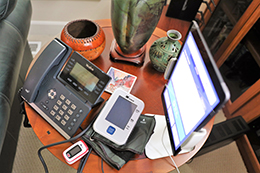
- Multiple daily video visits with your doctor or nurse.
- 24/7 access to your care team. You can reach us any time.
- Close contact with your primary care provider, especially when you are discharged.
- Frequent vital signs monitoring. We will check your temperature, breathing and pulse.
- Medications adjusted and delivered daily as needed.
- IV therapy as needed, including antibiotics and fluids.
- Laboratory tests and imaging as needed.
- Easy-to-heat meals that fit your diet.
- Physical and occupational therapy to help you get stronger.
- A daily schedule of who will visit you and when.
For patients and caregivers
You can reach us 24 hours a day:
- Call 503-922-7949
- Pick up your gray handset
Learn more
‘Well taken care of’
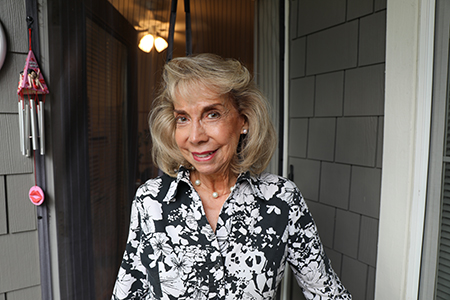
Meet a Hospital at Home patient who appreciated pairing hospital-level care with the comfort of her home in Portland.
Family first
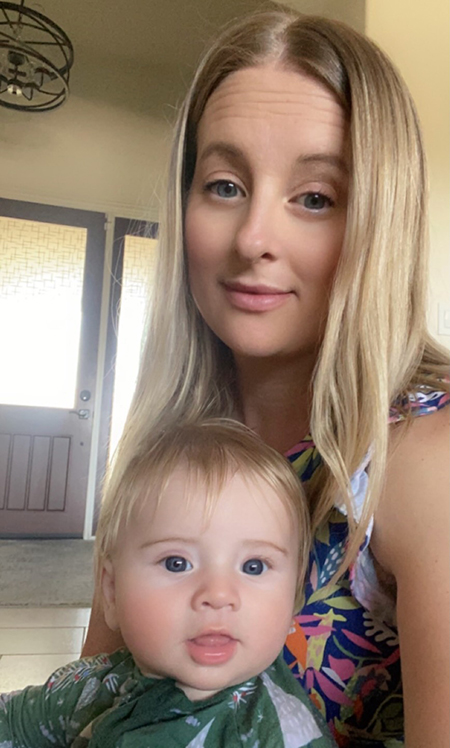
After Jen Marbach's second child was born, her kidneys failed and she had to stay at OHSU. As a Hospital at Home patient, she went home to her family and still got daily care.
Sample Hospital at Home schedule
This example shows what types of home visits a Hospital at Home patient might have. Your length of stay, number of daily visits and treatments will depend on your needs.
Day of admission
- In-home admission visit and IV therapy session
- Video visit with doctor
- Oxygen delivery and lab testing in your home
Day 1
- In-home nurse visit, with doctor on two-way video
- IV therapy session and video visit to check on you and answer questions
- Lab testing in your home
- Nurse Practitioner in-home visit
Day 2
- Doctor visit through two-way video
- IV therapy session and metered-dose inhaler breathing treatment
- X-ray and video visit to check on you and answer questions
- Lab testing in your home
Day 3
- In-home nurse visit, with doctor on two-way video
- IV therapy session and video visit to check on you and answer questions
- Lab testing in your home
Day 4
- Doctor visit through two-way video
- IV therapy session and video visit to check on you and answer questions
- Lab testing in your home
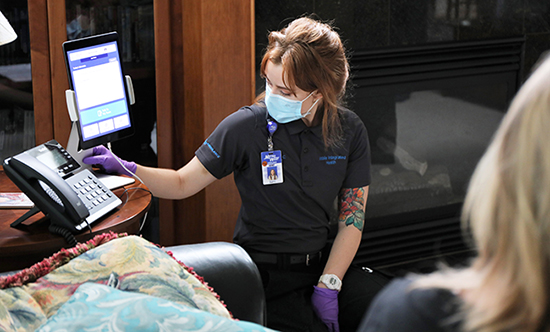
How Hospital at Home benefits patients
Hospital at Home patients say that being at home is more comfortable and convenient than being in the hospital. They also enjoy having more control over their sleep, activities, meals and space.
Studies comparing hospital-at-home care with a hospital stay show many benefits:
- Shorter stay
- Less chance of readmission within 30 days
- Less time sitting still or lying down
- Better sleep
Frequently asked questions on Hospital at Home
In a medical or environmental emergency, push the emergency button.
Medical emergencies include:
- Trouble breathing
- Fall with injury
- Can’t move
- Loss of consciousness
- Seizures
- Bleeding uncontrollably
- Severe chest pain
- Choking
Environmental emergencies include:
- Unexpected power outage
- Evacuation order
- Wildfire
- Earthquake
- Flooding
For other questions or concerns, contact your care team any time, day or night. Pick up your gray handset – no dialing needed.
Yes. You can reach your care team any time, day or night. Push the talk to my team button or pick up your gray handset – no dialing needed.
You or your caregiver can also call OHSU Health Hospital at Home at 503-922-7949.
Yes. We offer our Hospital at Home service to patients who may benefit from recovering at home. It is your choice if you want to take part.
At your admission visit, we will show you and your caregiver how to use all of the communications tools we bring to your home. Nurses and other medical staff will come to your home to provide medical care.
The out-of-pocket costs will be the same as if you were in the hospital. There is no additional cost to you.
Yes. We work closely with your primary care provider throughout your care. At discharge, we will send them a detailed report.
To keep you safe and help you recover, you should stay home while you are a Hospital at Home patient. Just as if you were staying in the hospital, your activity level will depend on your diagnosis and condition. When you are discharged from Hospital at Home, you may go back to your regular activities.
Having a caregiver in your home is not required. We will talk with you to decide if you could benefit from Hospital at Home, and the support you need depends on your condition. We can provide extra help at home, like home health aides and physical therapy services.
Hospital at Home research
- Hospital-Level Care at Home for Acutely Ill Adults: A Randomized Controlled Trial, Annals of Internal Medicine, 2020
- Hospital-Level Care at Home for Acutely Ill Adults: A Qualitative Evaluation of a Randomized Controlled Trial, Journal of General Internal Medicine, 2021
- Outcomes of Hospital at Home for Older Adults with and without High Levels of Social Support, Home Healthcare Now, 2021